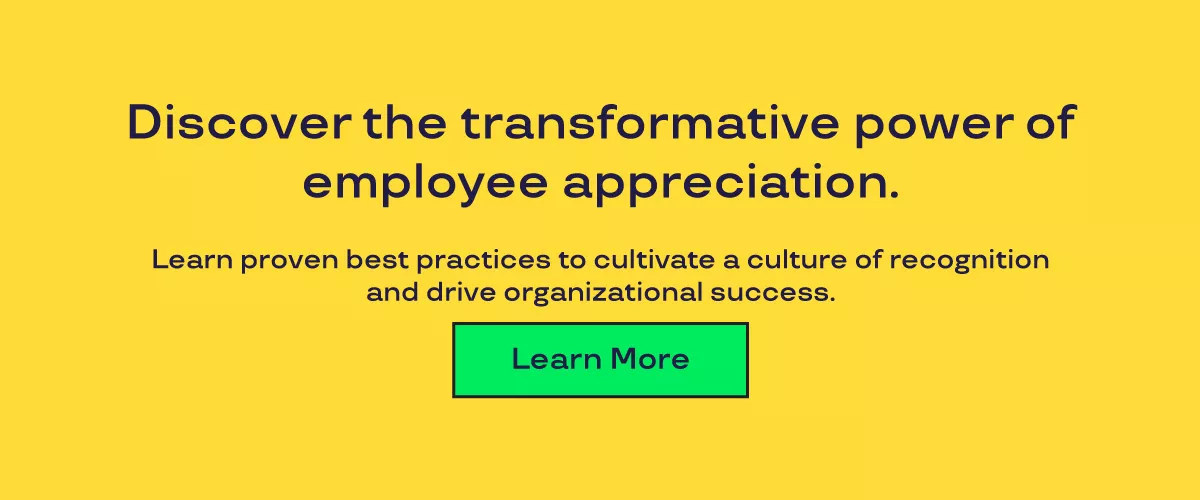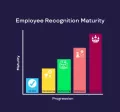
9 Powerful Benefits of Employee Appreciation & Recognition Programs
January 12, 2024
Employee appreciation and recognition programs are among the most underrated ways to foster a positive work culture, improve the employee experience, and boost business outcomes.
In the modern workplace, building a culture of appreciation isn't just a nicety—it's a strategic imperative. In fact, studies show that employee recognition increases employee engagement, productivity, performance by 14%.
The best employee appreciation and recognition programs go beyond superficial gestures and informal praise. They act as a cornerstone for cultivating engagement and productivity within an organization. However, maximizing their impact requires a nuanced approach.
We'll delve into the art and science of these programs, exploring the key elements that elevate these initiatives from checkbox formalities to powerful drivers of employee satisfaction and organizational success. From understanding individual preferences to designing tailored recognition frameworks, we uncover the strategies that not only amplify the benefits of these programs but also create a work environment where appreciation thrives organically.
Employee appreciation and recognition programs can offer immense potential to transform workplace dynamics, but their effectiveness often hinges on the authenticity of recognition. Beyond the tangible rewards lie intangible yet invaluable elements—acknowledgment, respect, and a sense of belonging and purpose. In this exploration, we uncover the many facets of appreciation and dissect its impact on morale, team dynamics, and overall company culture. We aim to equip organizations with actionable tactics to strengthen their appreciation and recognition initiatives for maximum returns.
What are Employee Appreciation Programs?
Employee appreciation programs are a combination of policies and procedures that designate when, how, and for what employees should receive recognition. Ideally, the program includes mechanisms for leaders to recognize team members and for employees to recognize their peers. The best employee appreciation programs, according to SHRM advice, “are most successful when they are aligned with the organization's mission, vision, values and goals.” Employees can and will notice when there is a gap between what leaders say is important and what behaviors are actually rewarded causing confusion and frustration.
Examples of employee appreciation programs include awards for service anniversaries, strong individual performance, client growth or retention, customer service achievements, innovative solutions, and other notable accomplishments. Many employers also include rewards for personal development, from training and education to personal milestones like birthdays, marriages, and becoming a parent. The best programs acknowledge effort as well as successes, and the accompanying award is something that the employee values—such as additional paid time off, cash bonuses or flexible spending.
In any discussion around new or expanding HR programs, there is always the question of cost. With operational budgets under continued strain, it’s crucial to understand that employee appreciation programs don’t need to break the bank to be effective. In fact, some of the most impactful strategies are low or no cost. Simple, heartfelt gestures can profoundly boost morale without significant financial investment. While tangible rewards or incentives have their place, the thoughtful and sincere acknowledgment of an employee's contributions often carries more weight than monetary value, making cost-effective appreciation strategies just as—if not more—valuable in cultivating a culture of recognition within an organization.
The Benefits of Employee Appreciation and Recognition Programs
Structured employee appreciation and recognition programs offer a wide range of benefits that can grow over time.
#1 Increased Employee Morale
Recognizing and appreciating employees for their efforts boosts morale, leading to a happier and more motivated workforce. “Accurate employee evaluation and recognition boosts employee perceptions of fairness,” according to Gartner. However, only 24% of employees report feeling acknowledged for their contributions. Managers are typically called on to create this feeling of acknowledgement, but Gartner research reveals that in a hybrid environment, managers tend to favor on-site employees over remote employees. According to a Gartner November 2020 survey of nearly 3,000 managers, 64% said that on-site employees are higher performers, while 75% say that on-site employees are more likely to be promoted.
#2 Improved Employee Engagement
Appreciated employees tend to be more engaged with their work, leading to higher productivity and better quality of work. Research by Great Place to Work found a link between simple gestures of gratitude and a willingness to work hard. “It turns out, a genuine 'thank you' from those in the corner offices can ignite a 69% increase in the likelihood of employees bringing their extra effort to the work floor.” Survey respondents also ranked employee recognition as the top driver of great work by a significant margin. (Self-motivation, inspiration, and autonomy ranked 2-4, each with one-third as many votes.)
#3 Reduced Turnover
When employees feel valued, they are more likely to stay with the company, reducing turnover rates and associated recruitment costs. According to Zippia, two-thirds (66%) of all employees said they would leave their job if they didn’t feel appreciated—and the figure jumps to 76% among millennials.
How much is turnover costing you and your organization? Find out with our calculator.
#4 Positive Company Culture
Regular recognition contributes to a positive work culture, fostering teamwork, collaboration, and a supportive environment. Proactively rewarding behaviors that are valued in your organizational culture mean employees are more likely to repeat them, thereby fueling and reinforcing the desired culture.
#5 Increased Productivity
Employees who feel appreciated are generally more motivated to perform well, leading to increased productivity and efficiency. Historical data from Gallup suggested that employees need recognition at least once every seven days in order to “to ensure that the employee knows the significance of the recent achievement and to reinforce company values.”
#6 Boosted Innovation and Creativity
Appreciated employees feel more comfortable sharing ideas and thinking creatively, which can drive innovation within the company. Research by World at Work revealed a majority (71%) of organizations use employee recognition to encourage high performance.
#7 Better Health and Well-being
Recognition can reduce stress and improve mental health among employees, leading to a healthier and more balanced work environment. Deloitte’s research on human-centered workforce design study revealed that more than three-quarters (85%) of employees who are regularly recognized felt their employer cared about their well-being.
#8 Improved Customer Satisfaction and Profitability
Happier employees are often more inclined to provide better customer service, directly impacting customer satisfaction levels. When employees are happy, companies tend to enjoy higher profits as well. Many business analysts and countless research studies have illuminated clear links between high levels of disengagement and higher absenteeism, lower productivity, and more mistakes, suggesting that higher engagement and satisfaction could reverse those effects.
#9 Attraction of Top Talent
A company known for its culture of appreciation is more attractive to potential hires, helping attract and retain top talent. According to Zippia, nearly half (46%) of job seekers said company culture is an important factor in decisions on where to apply and more than one-third (35%) said they would pass on ‘the perfect job’ if the culture was not a good fit for them.
How to Set up an Employee Appreciation and Recognition Program
The best way to set up a new employee appreciation and recognition program—or perform a much-needed update on an outdated or underutilized program—is to start with your ‘why.’ Spend some time in conversation with other organizational leaders about your company’s mission, values, and culture. Identify the specific characteristics and behaviors you wish to cultivate through your employee recognition program, and then reverse-engineer a program that does exactly that. There is no one correct way to create an employee appreciation program, except the way that best reflects your mission, values, culture, and goals.
One of the most important elements of a successful employee appreciation and recognition program is its consistency. Creating policies and procedures can help give your program shape but that’s not all you can do to set your program up for maximum efficacy and efficiency. Implementing the right employee engagement platform can bring your employee appreciation program to life—and ensure that everyone can participate equally, regardless of their work schedule or location.
And on that note, it’s also crucial to educate managers on the aims and expectations of your program. Gartner and other research sources have repeatedly noted a bias toward on-site employees in a hybrid environment. The best employee appreciation programs can help level the playing field, provided managers acknowledge the challenges at play and are held accountable for implementing employee recognition fairly and consistently.
To recap, the key steps for setting up an employee appreciation and recognition program are:
- Identify characteristics and behaviors that reflect your mission and values;
- Create policies and procedures to give your program structure;
- Leverage innovative technology to create a level digital playing field; and
- Involve managers in implementing the program, holding them accountable when needed.
Employee Appreciation and Recognition Ideas
As we mentioned earlier, there is no one-size-fits-all employee appreciation program, and that includes the specific reasons for recognition and the awards you dole out. Remembering that the most effective employee appreciation ideas will reflect your company values and reward people who embody those values, consider which employee recognition program ideas will work best in your organization and for your employees.
Here are some reward and recognition program examples to get you started:
- Awards for service milestones, starting early (30-day, 90-day, six-month, one-year, and annually after that)
- Rewards for contributions to projects that have clear end dates (e.g. creating a new marketing plan, building a new customer service portal, or developing a presentation to get internal support for a new initiative)
- Spot bonuses for employees who go above and beyond (e.g. taking on extra work during a colleague’s leave, pitching in to train a new hire, demonstrating company values in unique circumstances)
- Peer recognition rooted in gratitude
- Lunch with the C-suite executive of their choice
- Additional PTO to be used within the next 30 days (attaching a deadline encourages employees to utilize this reward!)
- Handwritten thank-you notes with gift cards (e.g. coffee shop, groceries, meal delivery services, online retailers)
- Digital recognition on your company intranet and employee engagement platform
One of the best things about employee appreciation and recognition programs is that they can evolve and grow over time. Collecting regular feedback from employees helps you measure the efficacy of your employee appreciation program and offer rewards that are most meaningful for your employees—even as their needs and preferences change over time.
Of course, some award types are more inclusive and flexible than others, and it’s beneficial to offer employees the opportunity to choose their reward when possible, so they can select something they truly want and need. This can simultaneously give employees a better perception of your recognition program and help them feel seen as unique individuals.
Unlocking the Art of Employee Appreciation for Lasting Success
Employee appreciation and recognition programs are a pivotal yet often underestimated tool for shaping a thriving workplace ecosystem. They embody not just gestures of recognition but effective strategies to fuel a positive work culture, enhance the employee experience, and ultimately bolster business outcomes. By transcending superficial acts of praise, these programs become a foundation for cultivating engagement, productivity, and innovation.
In this guide, we’ve explored into the nuanced art and science behind such initiatives, revealing the key elements that elevate them from mere formalities to potent catalysts for employee satisfaction and organizational success. The strategies outlined here not only amplify the benefits of employee appreciation programs but also lay the groundwork for an environment where appreciation naturally flourishes.
The significance of employee appreciation and recognition programs is underscored by their multifaceted impacts. Structured initiatives like these drive increased morale, heightened engagement, reduced turnover, and foster a positive company culture. They help amplify productivity, spark innovation, and cultivate better overall well-being among employees. Beyond these tangible benefits, they can help attract top talent and create an environment where everyone feels valued and acknowledged for their contributions.
Establishing or refining such programs—rooted in organizational values, consistent policies, and inclusive practices—empowers business leaders to not only celebrate achievements but also foster an environment where every employee feels seen, heard, and appreciated, thereby propelling the organization toward enduring success.





